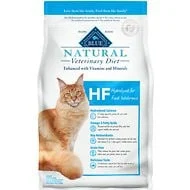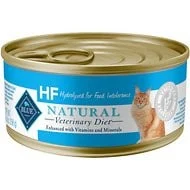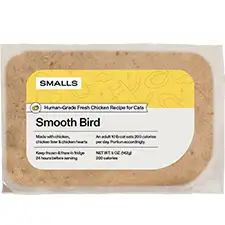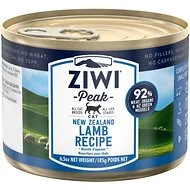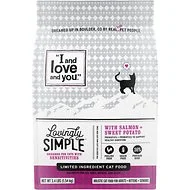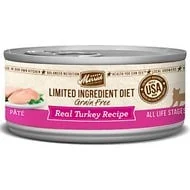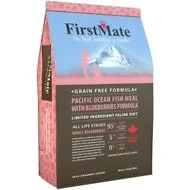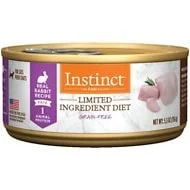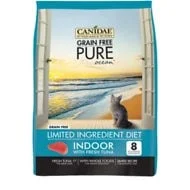9 Best Hydrolyzed Protein Cat Food in 2025
Quick Guide
- What Is The Best Hydrolyzed Protein Cat Food?
- What is Hydrolyzed Protein?
- Is Hydrolyzed Protein Good for Cats?
- What Should You Look for in a Hypoallergenic Cat Food?
- How Do We Make Cat Food Recommendations?
- The Best Hydrolyzed Protein Cat Foods
- The 7 Best Cat Foods for Allergies
- Smalls Fresh Bird Cat Food Delivery Service
- Ziwi Peak Lamb Recipe Canned Food
- I and Love and You Lovingly Simple LID Salmon & Sweet Potato Dry Food
- Merrick Limited Ingredient Diet Grain-Free Real Turkey Recipe Pate Canned Food
- FirstMate Pacific Ocean Fish Meal with Blueberries Formula LID Grain-Free Dry Food
- Instinct Limited Ingredient Diet Grain-Free Pate Real Rabbit Recipe Canned Food
- Canidae Grain-Free PURE Ocean with Tuna Indoor Formula Limited Ingredient Diet Dry Food
- Frequently Asked Questions
Your cat is a carnivore, there’s no two ways about it. Though dogs have the ability to subsist on plant foods in a pinch, your cat’s body simply isn’t designed to process plant matter. He has a short digestive system and lacks the enzyme herbivores have that helps them break down fiber.
All this being true, protein is the essential foundation of your cat’s diet. Animal protein from meat, poultry, or fish sources is best but those aren’t the only kinds you’ll see on a cat food label. In fact, you may come across recipes made with something strange – hydrolyzed protein.
[sc name=”best-hydrolyzed-protein-cat-food-table-code”]In this article, we’ll talk about what hydrolyzed protein is and what role it plays in cat food, particularly for cats with food allergies. We’ll talk about the pros and cons and help you determine if an alternative to hydrolyzed protein cat food might be a better option for your cat. From there, we’ll show you what to look for in a good cat food recipe and provide you with some recommendations.
What Is The Best Hydrolyzed Protein Cat Food?
- Blue Buffalo Natural Veterinary Diet HF Hydrolyzed
- Blue Buffalo Natural Veterinary Diet HF Hydrolyzed Canned
- Ziwi Peak Lamb Recipe Canned Food
- I and Love and You Lovingly Simple LID Salmon & Sweet Potato
- Merrick Limited Ingredient Diet Grain-Free Real Turkey Recipe
- FirstMate Pacific Ocean Fish Meal with Blueberries Formula LID
- Instinct Limited Ingredient Diet Grain-Free Pate Real Rabbit
- Canidae Grain-Free PURE Ocean with Tuna Indoor Formula
What is Hydrolyzed Protein?
When scanning a pet food label, you may not understand everything you read but it isn’t hard to pick out some of the bad ingredients – things that sound like chemicals. So, what do you do when you come across something like hydrolyzed protein?
Hydrolyzed protein is a scary-sounding name, but the actual product isn’t as bad as you might imagine. Basically, hydrolyzing protein involves breaking down long protein strands into smaller chains or even single amino acids. It involves breaking the peptide bonds that hold those amino acids together, typically accomplished using enzymes. Partially hydrolyzed proteins have their amino acids cut into smaller segments while fully hydrolyzed proteins are completely separated.
The idea behind hydrolyzed protein is that by breaking it down before it enters the body, the body can absorb them more readily. They are basically pre-digested.
Is Hydrolyzed Protein Good for Cats?
Before answering this question, let’s talk about why you might consider a hydrolyzed protein cat food in the first place. The main reason for breaking down proteins is to change the way your cat’s body reacts to them. For cats with food allergies, the body may not recognize hydrolyzed proteins the same way as whole proteins and may not have the same negative response.
This is why many veterinary diets for food allergies are made with hydrolyzed protein. But is it actually a good option for cats?
The answer to this question depends on the answers to several other questions. Is the protein hydrolyzed from animal protein or plants? Does the cat have an allergy to a specific animal protein? Would an alternative to hydrolyzed protein cat food be just as effective?
Generally speaking, we’re in favor of feeding your cat a diet that approximates his natural diet as closely as possible. Many pet nutrition experts advocate for a raw diet, but we understand that isn’t affordable or practical for many pet owners. That being said, we do our best to provide you with recommendations for the highest quality commercial diets for your cat.
We don’t believe hydrolyzed protein is the best option for cats. The fact is that most hydrolyzed cat food brands are veterinary diets like Hill’s Science Diet and Royal Canin Veterinary Diet which are known for using low-quality ingredients. In fact, many use hydrolyzed soy protein rather than hydrolyzed animal protein. Your cat may not have an allergic reaction to it, but it won’t be as biologically valuable as animal protein. If it doesn’t benefit your cat, what’s the point?
As an alternative to hydrolyzed protein cat food, we recommend limited ingredient cat food. It accomplishes the same purpose of preventing an allergic reaction but simply by reducing the number of ingredients rather than chemically changing them.
What Should You Look for in a Hypoallergenic Cat Food?
Cat food allergies can be tricky to deal with, especially if you’re not sure what your cat is allergic to. If you’re not sure, your best bet is to switch to a limited ingredient cat food made with a novel source of protein and, ideally, a novel source of carbohydrate. Good options for proteins including things like turkey, venison, and salmon. For carbohydrates, check to see what’s in your cat’s current food and then avoid it. If he’s currently eating whole grains, switch to a grain-free recipe. If he’s on a grain-free recipe, maybe try something with whole brown rice or potato.
It can be a matter of trial and error to find a cat food that won’t trigger your cat’s allergies. In addition to choosing a novel protein and carbohydrate, however, there are some general things you should look for to ensure the quality of whatever recipe you choose.
Here are some general things to look for in a good cat food:
- Real animal protein as the first ingredient. Unless you’ve decided on hydrolyzed protein cat food, choose a recipe with a real animal protein like meat, poultry, or fish as the first ingredient. Ideally, animal protein should be two of the first three ingredients.
- Healthy animal-based fats. Fat provides your cat with energy and essential fatty acids, plus it helps his body absorb fat-soluble vitamins. It is most biologically valuable when it comes from animal sources and you should look for a balance of omega-3s and omega-6s.
- Limited carbohydrate content. Cats are obligate carnivores, so protein is the most important nutrient for them. Digestible carbohydrates can provide some nutrients, but they should make up a small percentage of your cat’s diet.
- No artificial additives. Artificial colors, flavors, and preservatives provide no nutritional benefit to your cat – they are simply used to make the product look, taste, or smell more appealing. Avoid any product that contains artificial additives as well as fillers and low-quality by-products.
- Limited use of synthetic supplements. Most commercial cat foods contain added vitamins and minerals to ensure nutritional balance, but if there are a lot of supplements it implies that the quality of the ingredients may be low. If you see a lot of free amino acids (like taurine), you might worry that the quality of the protein in the recipe is low.
Now that you know what to look for in a high-quality cat food recipe, you’re ready to start shopping on your own! Before you do, however, we want to tell you how we make our cat food recommendations so you know whether you can trust the picks we’ve reviewed in depth below.
How Do We Make Cat Food Recommendations?
Picking a cat food can be tough because there are so many options out there. How do you know which one is better than any other and which one is right for your cat? We don’t expect you to become an expert in pet food, but we do want you to have the information you need to make a smart choice. We’ve already given you a lot of helpful information, but you’re probably still eager to see our recommendations. Before we give them to you, take a minute to learn how we make our choices so you know you can trust them. Remember, we only recommend products we would feel safe and confident feeding our own cats.
Here are some general requirements for a cat food recipe to receive our stamp of approval:
- A source of high-quality animal protein as the first ingredient
- At least 30% crude protein for kittens and at least 26% for adults
- A minimum of 9% crude fat for kittens and adults
- A balance of omega-3 and omega-6 fatty acids, primarily from animal sources
- A rich blend of nutrients from natural sources and supplements, as needed
- Limited carbohydrate content from digestible sources (like whole grains and veggies)
- No low-quality fillers, by-products, or artificial additives (preservatives, dyes, or flavors)
If you’re considered one of the hydrolyzed protein cat food brands, we encourage you to talk to your veterinarian about what your cat really needs. For food allergies, you don’t necessarily need to switch to a veterinary diet – you simply need to avoid the ingredients your cat is allergic to. It could be as simple as choosing a limited ingredient diet made with a novel source of protein.
The Best Hydrolyzed Protein Cat Foods
Based on what you’ve read so far, you shouldn’t be surprised that we don’t heartily recommend hydrolyzed protein cat food. Your veterinarian is the only one who can truly say whether this diet is best for your cat but we encourage you to explore the alternatives if he suggests it. If you really do what to feed your cat hydrolyzed protein, these are the two recipes we recommend:
Blue Buffalo Natural Veterinary Diet HF Hydrolyzed for Food Intolerance Dry Food
You’re unlikely to find a non prescription hydrolyzed protein cat food, but if you are willing to pay the price for prescription we can recommend this Blue Buffalo Natural Veterinary Diet HF Hydrolyzed for Food Intolerance recipe. Formulated specifically for cats with food allergies and intolerances, this formula features hydrolyzed salmon as a highly digestible form of animal protein. This recipe is rich in omega-3 fatty acids for healthy skin and coat, plus it is enriched with key antioxidants to boost your cat’s immunity. This recipe is grain free as well, further reducing the risk for allergies and intolerance and has a natural flavor your cat will love.
Blue Buffalo Natural Veterinary Diet HF Hydrolyzed for Food Intolerance Canned Food
For cats with food allergies and intolerance, it’s important to find a recipe that is gentle on the stomach in addition to one that doesn’t contain the food your cat is allergic to. For very sensitive cats, a wet food like this Blue Buffalo Natural Veterinary Diet HF Hydrolyzed canned food recipe is a good choice. It does require a prescription, but it is formulated specifically for food intolerance and made with hydrolyzed salmon. Hydrolyzed salmon is a highly digestible protein supported by fish oil and flaxseed to provide plenty of omega-3s. The formula also contains blueberries and cranberries as natural sources of antioxidants with no corn, wheat, soy, or artificial additives.
The 7 Best Cat Foods for Allergies
If you really believe hydrolyzed protein is the best option for your cat and you have your veterinarian’s support, we can really only recommend the two Blue Buffalo Natural Veterinary Diet recipes reviewed above. If you’re looking for a non prescription hydrolyzed protein cat food, you’re unlikely to find one.
We don’t want to be too negative about veterinary diets because they can be therapeutic in some cases. When it comes to cat food allergies, however, an alternative to hydrolyzed protein cat food can be just as effective and is likely to be more nutritious than a veterinary diet.
Here are our recommendations for limited ingredient cat food perfect for cats with allergies:
Smalls Fresh Bird Cat Food Delivery Service
When it comes to high-quality cat food, fresh food provides excellent nutritional value for cats. Made in smaller batches with high-quality ingredients, Smalls fresh food is our top pick. Simply provide basic information about your cat’s age, weight, and activity level so they can calculate his calorie requirements then you’ll be sent automatic shipments of fresh food right to your door. Smalls offers two recipes, one with chicken and one with beef, both made with fresh fruits and vegetables. You can talk to the company about your concerns if your cat has a specific food allergy and they may be able to work with you on a custom meal plan.
Ziwi Peak Lamb Recipe Canned Food
Though not marketed as a limited ingredient diet, this canned food from Ziwi Peak contains a single source of animal protein and a limited list of main ingredients. It contains 92% meat, organs, and New Zealand mussels which are a natural source of joint-supporting glucosamine and chondroitin. As a canned food, this formula is rich in moisture which benefits your cat’s hydration as well as his digestive health. This recipe features 100% single-sourced lamb that is free-range, grass-fed, and ethically and sustainably sourced from New Zealand free from antibiotics and growth hormones.
I and Love and You Lovingly Simple LID Salmon & Sweet Potato Dry Food
Formulated specifically for cats with food allergies and sensitivities, this I and Love and You Lovingly Simple LID Salmon & Sweet Potato is a great choice in limited ingredient dry cat food. It features fresh salmon as the main ingredient and is completely free from poultry. It is grain-free, made with digestible carbohydrates like peas, sweet potatoes, and chickpeas with a rich blend of healthy fats. It contains chelated minerals for optimal nutrient absorption and probiotics for healthy and regular digestion.
Merrick Limited Ingredient Diet Grain-Free Real Turkey Recipe Pate Canned Food
Turkey is a novel source of protein for many cats which makes it a great option for food allergies and sensitivities. This Merrick Limited Ingredient Diet Grain-Free Real Turkey Recipe features fresh turkey as the main ingredient with turkey broth for moisture and natural flavor. Turkey liver provides an additional source of protein with essential nutrients while flaxseed oil supplies essential fatty acids. This recipe is complete and balanced in terms of your cat’s minimum nutritional requirements and it has an estimated carbohydrate content under 5%.
FirstMate Pacific Ocean Fish Meal with Blueberries Formula LID Grain-Free Dry Food
Another limited ingredient diet for your cat to try is this FirstMate Pacific Ocean Fish Meal with Blueberries Formula. This recipe features Pacific Ocean fish as the main ingredient, making up 92% of the recipe’s total protein. Only 5% protein comes from vegetables and none from grains. This formula contains potato as the primary carbohydrate, a novel source for many cats, with fresh blueberries as a natural source of antioxidants and essential nutrients. You’ll also find added vitamins and minerals to ensure balanced nutrition with prebiotics to support your cat’s digestion.
Instinct Limited Ingredient Diet Grain-Free Pate Real Rabbit Recipe Canned Food
If you’re still having trouble finding a cat food made with a protein novel for your cat, you might try this Instinct Limited Ingredient Diet Grain-Free Pate Real Rabbit Recipe. It features fresh rabbit as a single source of animal protein with rabbit liver as well. This formula does contain some pea protein, but fresh peas are the only carbohydrate ingredient. It is rich in moisture and protein but contains a very limited list of ingredients, making it unlikely to trigger your cat’s allergies.
Canidae Grain-Free PURE Ocean with Tuna Indoor Formula Limited Ingredient Diet Dry Food
Indoor cats may not have significantly different nutritional needs than outdoor cats, but they can sometimes benefit from slightly higher fiber content to prevent hairballs. This Canidae Grain-Free PURE Ocean with Tuna Indoor Formula is designed for indoor cats but also made with a limited list of ingredients making it perfect for cats with allergies. It features tuna as the main ingredient with salmon meal and menhaden fish meal as the next two ingredients. It might not be ideal if your cat has a fish allergy, but it’s perfect for cats with allergies to chicken, beef, or lamb.
Frequently Asked Questions
- What is hydrolyzed protein cat food? As the name suggests, hydrolyzed protein cat food is a cat food recipe made with protein that has been hydrolyzed. This is a process through which the protein chains are broken into smaller segments or separated into isolated amino acids. By breaking up the proteins, it changes the way the cat’s body responds to it and prevents it from having an allergic reaction. Hydrolyzed protein cat food recipes are usually formulated for cats with food allergies or intolerance.
- What is the best food for cats with allergies? Though some veterinarians might recommend hydrolyzed protein for cat food allergies, that isn’t the only option. In fact, it may not even be the best option. The best way to treat a food allergy is to avoid the ingredient your cat is allergic to. There are hundreds of cat food recipes out there, maybe even thousands. That gives you a lot of room to find one that doesn’t contain the ingredient your cat is allergic to. You can narrow down your options by shopping for limited ingredient cat food.
- Can cats be allergic to hydrolyzed protein? No, hydrolyzed proteins do not cause allergenic responses. An allergic reaction is an immune response but because the protein is broken down to the point that it becomes unrecognizable by the immune system, it doesn’t trigger the same response and your cat won’t have a reaction.
- What protein are cats most allergic to? The most common cat food allergies are to proteins like chicken, beef, and fish. Most cats develop food allergies between the ages of 2 and 6 years old after being repeatedly exposed to it. This means that your cat is more likely to develop an allergy to chicken if you feed him chicken every day. Rotating your cat’s diet is not guaranteed to prevent food allergies, but some animal nutritionists think it may help.
- What is hypoallergenic cat food? The term hypoallergenic simply means unlikely to trigger an allergic response. Based on what you’ve learned already, you should be able to guess that hypoallergenic cat food differs from one cat to another depending what the cat is allergic to. If your cat is only allergic to chicken, a hypoallergenic cat food would simply be a recipe free from chicken ingredients.
Your cat’s food is his primary source of nutrition. Treats may be tasty, but they shouldn’t make up a significant part of your cat’s diet. Because it’s just about the only thing he eats, your cat’s food needs to provide for his nutritional needs in the healthiest way possible. When your cat develops a food allergy or intolerance, it complicates things, but it doesn’t mean you have to resort to an expensive (and possibly inferior) product like hydrolyzed cat food.
If you’re concerned about your cat’s allergies, talk to your veterinarian to rule out other potential causes for his symptoms. From there, you can try an elimination diet to see if his symptoms disappear. If they do and you’re able to identify the cause of the allergy, all you have to do is feed your cat a food free from that ingredient! One of our product recommendations above could be the perfect fit.


